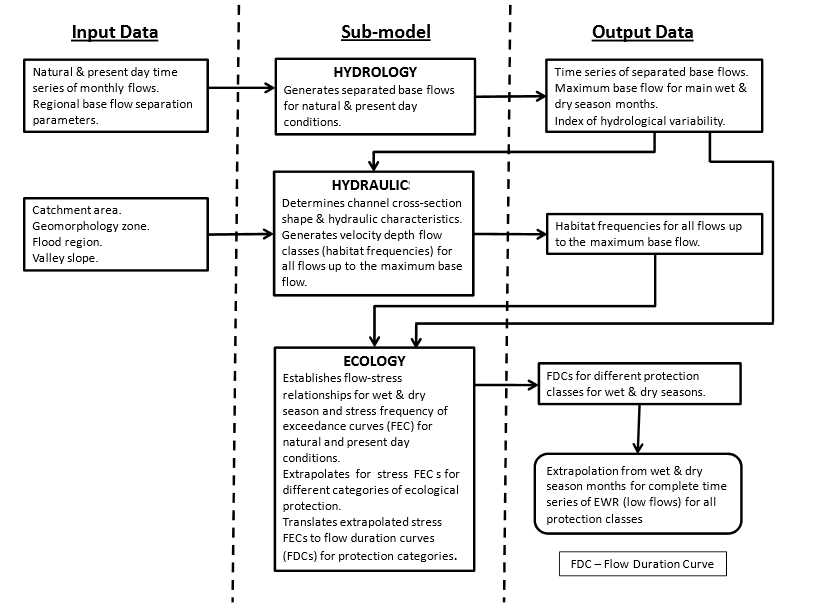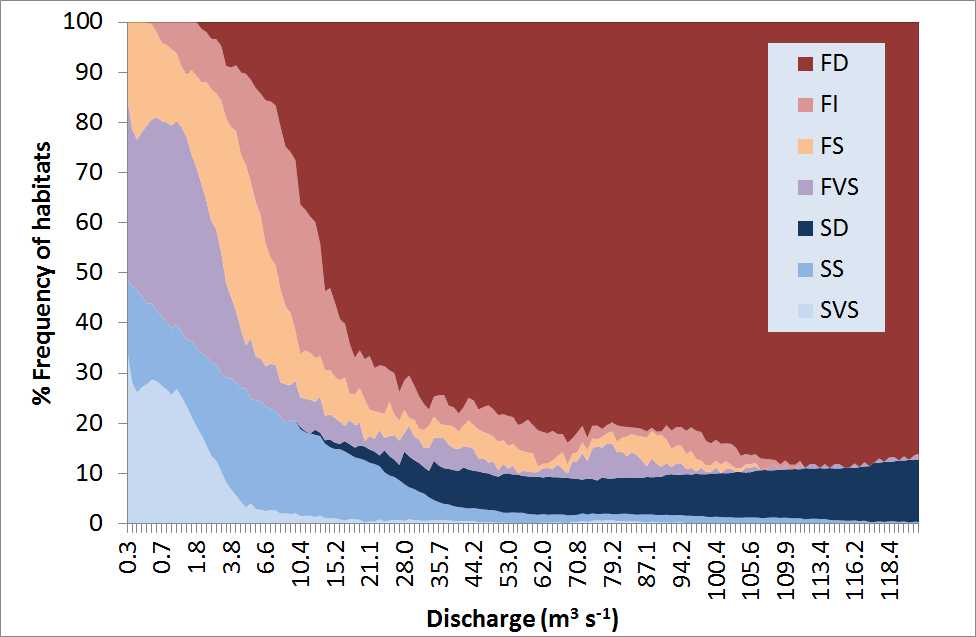The Institute for Water Research has been centrally involved in developing methods for quantifying the environmental water requirements (EWR) of the rivers of South Africa for many years. The concepts of environmental protection and the sustainable use of water resources was included in the South African Water Act of 1998 as the ‘Ecological Reserve’. The hydrology section of the IWR has developed, tested and applied a wide range of tools to support the determination of the ‘Reserve’. Many of these developments were associated with providing ‘desktop’ models that would allow rapid (but often low confidence) estimates of the Reserve or EWR in the absence of the time or specialist expertise resources to undertaken more detailed studies. The initial version of the Desktop Reserve Model was largely based on the use of hydrological indices to extrapolate from previous detailed study results to any other site based on regionalised parameters for the whole country. This model has also been used in several other countries of Africa and in a few other countries of the world.
As the whole science of EWR developed, so there was an identified need to update the approach used in the Desktop model. This led to the development of the Revised Desktop Reserve model that more explicitly links the relationships between hydrology (and variations of flow through time), hydraulics (the nature of the channel cross-section) and the ecological response to different flow regimes. The approach is largely based on the habitat (flow depth and velocity) requirements of the biota and how the actual habitat changes through the interaction of the channel hydraulics with different managed flow regimes. Figure 1 (extracted from the PhD thesis of Dr Ahmed Desai) illustrates the concepts of the revised model, while Figure 2 shows the variation in habitat (F = fast, S= slow, D=Deep and S=Shallow) with discharge.

Figure 1: Input data, sub-models and output data for the Revised Desktop Reserve model

Figure 2: Habitat frequency diagram (one of the outputs of the Revised Desktop Reserve model)
Further details of the concepts and research that has been completed can be found in the following publications:
Hughes, DA, O’Keeffe, J, Smakhtin, V and King, J (1997) Development of an operating rule model to simulate time series of reservoir releases for instream flow requirements. Water SA, 23(1), 21-30.
Hughes, DA, O’Keeffe, J and King, J (1997) Development of a reservoir release operating rule model to simulate demands for instream flow requirements and water resources. In: Sustainability of Water Resources under Increasing Uncertainty (Eds. D Rosbjerg, N-E Boutayeb, A Gustard, Z Kundzewicz & P Rasmussen), IAHS Publ. 240, 321-329.
Hughes, DA and Ziervogel, G (1998) The inclusion of operating rules in a daily reservoir simulation model to determine ecological reserve releases for river maintenance. Water SA. , 24(4), 293-302.
Hughes, DA (1999) Towards the incorporation of magnitude-frequency concepts into the Building Block Methodology used for quantifying ecological flow requirements of South African rivers. Water SA., 25(3), 279-284.
Louw, D, Hughes, DA & Birkhead, A (2000) The IFR process: beyond the specialist workshop. African Journ. Of Aquatic Science, 25, 183-190
Hughes, DA (2001) Providing Hydrological Information and Data Analysis Tools for the Determination of the Ecological Instream Flow Requirements for South African Rivers. Journ. Hydrol. , 241 (1-2), 140-151.
O’Keeffe, J, Hughes, DA & Tharme, R (2002) Linking ecological responses to altered flows, for use in environmental flow assessments: the Flow Stressor-Response method. Verh. Internat. Verein. Limnol., 28, 84-92.
Hughes, DA & Hannart, P (2003) A desktop model used to provide an initial estimate of the ecological instream flow requirements of rivers in South Africa. Journ. Hydrol., 270(3-4), 167-181.
Hughes, DA, Hannart, P & Watkins, D (2003) Continuous baseflow separation from time series of daily and monthly streamflow data. Water SA, 29(1), 43-48
Hughes, DA (2003) Environmental flow requirements in water resource planning and operation. Water Resources Systems—Hydrological risk, management and development (Proceedings of symposium HS02b held during IUGG2003 at Sapporo, July 2003). IAHS Publ. no. 281, 261-268.
Hughes, DA (2004) Problems of estimating hydrological characteristics for small catchments based on information from the South African national surface water resource database. Water SA, 30(3), 393-398.
Hughes, DA (2005) Hydrological issues associated with the determination of environmental water requirements of ephemeral rivers. River Research and Applications, 21(8), 899-908.
Smakhtin, VU, Shilpakar, RL & Hughes, DA (2006) Hydrology-based assessment of environmental flows: An example from Nepal. Hydrological Sciences Journal, 51(2), 207-222.
Hughes, DA (2006) A simple model for assessing utilizable streamflow allocations in the context of the ecological Reserve. Water SA, 32(3), 411-417.
Hughes, DA and Mallory SJL (2008) Including environmental flow requirements as part of real-time water resource management. River Research and Applications, 24(6), 852-861.
Hughes, DA (2009) Simulating the hydrology and total dissolved solids (TDS) of ephemeral rivers in South Africa for environmental water requirement determinations. River Research and Applications, 25(7), 850-860.
Hughes, DA and Louw, D (2010) Integrating hydrology, hydraulics and ecological response into a flexible approach to the determination of environmental water requirements for rivers. Environ. Model. & Software, 25(8), 910-918. [Awarded the best paper of 2010 for this journal]
Sawunyama, T and Hughes, DA (2010) Using satellite-based rainfall data to support the implementation of environmental water requirements in South Africa. Water SA 36(4), 379-385.
Hughes, D.A., Desai, A.Y., Birkhead, A.L. and Louw, D. (2014) A new approach to rapid, desktop level, environmental flow assessments for rivers in southern Africa. Hydrological Sciences Journal, 59(3-4), 673-687.
Hughes, DA & Munster, F (2000) Hydrological information and techniques to support the determination of the water quantity component of the Ecological Reserve for rivers. Water Research Commission Report No. TT 137/00.
Hughes, DA (Ed) (2004) SPATSIM, an integrating framework for ecological Reserve determination and implementation. Water Research Commission Report No. TT 245/04.
Hughes, DA (2008) Hydrological information requirements and methods to support the determination of environmental water requirements in ephemeral rivers. Water Research Commission Report No. KV 205/08.
Hughes, DA, Mallory, SJL and Louw, D (2008) Methods and software for the real-time implementation of the ecological Reserve – explanations and user manual. Water Research Commission Report No. 1582/1/08.
Rivers-Moore, NA, Hughes, DA and Mantel, S (2008) Links between water temperatures, ecological responses and flow rates: A framework for establishing water temperature guidelines for the ecological Reserve. Water Research Commission Report No. KV 214/08.
Seaman, MT, Avenant, MF, Watson, M, King, J, Armour, J, Barker, CH, Dollar, E, du Preez, PJ, Hughes, D, Rossouw, L and van Tonder, G. (2010) Developing a method for determining the environmental water requirements for non-perennial systems. Water Research Commission Report No. TT 459/10.
Hughes, DA, Louw, D, Desai, AY and Birkhead, AL. (2012) Development of a revised desktop model for the determination of the ecological reserve for rivers. Water Research Commission Report No. 1856/1/11.
Last Modified: Tue, 22 Nov 2016 12:23:44 SAST